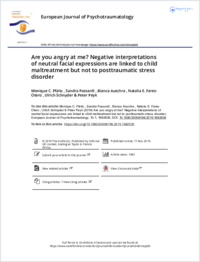Are you angry at me? Negative interpretations of neutral facial expressions are linked to child maltreatment but not to posttraumatic stress disorder.
- Pfaltz MC Department of Consultation-Liaison Psychiatry and Psychosomatic Medicine, University Hospital Zurich, University of Zurich, Zurich, Switzerland.
- Passardi S Department of Consultation-Liaison Psychiatry and Psychosomatic Medicine, University Hospital Zurich, University of Zurich, Zurich, Switzerland.
- Auschra B Department of Consultation-Liaison Psychiatry and Psychosomatic Medicine, University Hospital Zurich, University of Zurich, Zurich, Switzerland.
- Fares-Otero NE Department of Consultation-Liaison Psychiatry and Psychosomatic Medicine, University Hospital Zurich, University of Zurich, Zurich, Switzerland.
- Schnyder U Department of Consultation-Liaison Psychiatry and Psychosomatic Medicine, University Hospital Zurich, University of Zurich, Zurich, Switzerland.
- Peyk P Department of Consultation-Liaison Psychiatry and Psychosomatic Medicine, University Hospital Zurich, University of Zurich, Zurich, Switzerland.
- 2019-11-26
Published in:
- European journal of psychotraumatology. - 2019
Emotion recognition
ambiguous social stimuli
childhood trauma
negative perceptual bias
neutral facial expressions
posttraumatic stress disorder
English
Background: Individuals with a high prevalence of child maltreatment, e.g. those with borderline personality disorder, tend to see neutral facial expressions as negative. Objective: Our aim was to assess whether this bias is present in individuals with posttraumatic stress disorder (PTSD) and whether it is linked to child maltreatment. Methods: Thirty-nine PTSD participants, 44 traumatized and 35 non-traumatized healthy controls watched 300 one-second movies showing 30 neutral and 270 emotional facial expressions, and indicated whether they interpreted each as a neutral or as one of nine emotional expressions. Results: PTSD individuals did not perform differently than the two control groups in the recognition and interpretation of neutral facial expressions (p's < .300). Higher levels of childhood sexual and emotional abuse, and physical neglect were linked to more interpretations of neutral facial expressions as contempt (p's < .043), and (for sexual abuse and physical neglect) to more interpretations of neutral facial expressions as anger (p's < .014). Comparisons of statistical model fits suggested that childhood sexual abuse was the most relevant predictor of recognition accuracy in our sample. Alexithymia, state dissociation, interpersonal trauma, and number of experienced trauma types were not associated with deficits in the interpretation of neutral expressions. Conclusions: Child maltreatment, especially sexual abuse, may shape the interpretation of neutral facial expressions. Future research should explore whether the observed biases extend to real-life situations. If so, therapists might improve the therapeutic relationship with patients with a history of child maltreatment by paying more attention to their own non-verbal communication and their patients' responses to it. Furthermore, similarly to individuals with high depressive and high social anxiety symptoms, facial expression recognition training might counteract negativity bias in individuals with a history of childhood (sexual and emotional) abuse, and (physical) neglect.
- Language
-
- English
- Open access status
- gold
- Identifiers
-
- DOI 10.1080/20008198.2019.1682929
- PMID 31762947
- Persistent URL
- https://sonar.ch/global/documents/119702
Statistics
Document views: 10
File downloads:
- fulltext.pdf: 0
